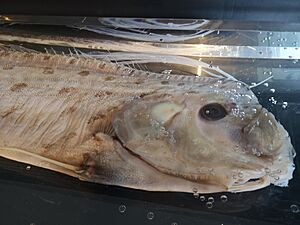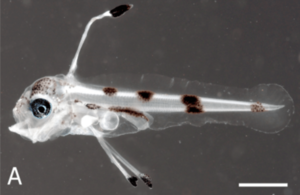Russell's oarfish facts for kids
Quick facts for kids Russell's oarfish |
|
|---|---|
 |
|
| A preserved Russell's oarfish at Academia Sinica in Taipei | |
| Conservation status | |
| Scientific classification | |
| Genus: |
Regalecus
|
| Species: |
russelii
|
The Regalecus russelii, also known as Russell's oarfish, is a type of oarfish. It belongs to the Regalecidae family. This amazing fish lives in deep ocean waters all around the world. You can find it in the bathypelagic zone, which is a very deep part of the ocean. The Russell's oarfish has no scales. It looks long and flat, like a ribbon. It can grow up to 8 meters (about 26 feet) long!
Contents
What is Russell's Oarfish?
The Russell's oarfish is part of the fish group called Regalecus. There is only one other known oarfish species in this group, called Regalecus glesne. Both are part of a larger group of fish called Lampriformes. This group includes fish with tube-shaped eyes and ribbon-like bodies. All these fish are also part of the Actinopterygii class, which means they are ray-finned fish.
How Does It Look?
Russell's oarfish can grow to be very long, up to 8 meters. It has two special fins on its back called dorsal fin crests. These crests can stand up to 1 meter (about 3 feet) tall! You can tell this oarfish apart by its red dorsal fin crests. Its head is light brown, and its body is shiny silver. It does not have scales.
Instead of scales, its body is covered in small bumps called dermal tubercles. These bumps are mostly found on its belly and lower sides. Each dorsal fin has many small bones called rays, usually between 333 and 371. These rays get shorter, then longer again in the middle of the body. Its pelvic fin has one long ray with more than three soft parts.
The stomach of the oarfish has a long tube-like part called a caecum. This part starts behind its belly and goes all the way to the end of its body. Older Russell's oarfish often have a short, blunt tail. This happens because they can cut off their own tail, a process called self-amputation. But the tail does not grow back. Sometimes, the tail looks rough and not fully healed, like it was just cut off.
Most of these fish do not have teeth. But some have very tiny, leftover teeth. Their spine has many bones, usually 113 to 122 vertebrae. Their skeleton has some parts that are extra strong and thick. This is called hyperostosis. These strong bones are mostly in the dorsal fins. They are also found in the shoulder bone and at the back of the skull. The rest of the skeleton is soft, like cartilage.
The strong bones help support the dorsal fins when the fish moves. Scientists also think these strong bones help the oarfish float in deep water. Not all Russell's oarfish have these strong bones. Most large adult fish have them, but many smaller fish do not. The oarfish's soft skeleton helps it stay afloat easily in the deep ocean.
One part of the oarfish that scientists have studied is its otolith. This is a small structure in its inner ear. It helps the fish sense movement and gravity. Russell's oarfish have very tiny otoliths, which are hard to see. Their small size might mean they are not very important for sensing movement. Researchers have used special scans and studies on dead oarfish to learn more about these tiny ear parts.
Where Do They Live?
Russell's oarfish live in deep waters around the world. You can find them near places like Japan, California, and Baja California. They live in the Pacific, Atlantic, and Indian oceans. These oarfish usually stay in the mesopelagic zone, which is a middle depth of the sea.
Since 1901, people have seen or found Russell's oarfish on the coast of California 19 times. The Russell's oarfish lives near the equator around the world. Another type, Regalecus glesne, is found in different areas, usually far from the equator. Regalecus glesne are also mesopelagic fish. They spend most of their time at depths of about 300 to 1000 meters (about 980 to 3,280 feet).
In June 2022, a young oarfish was seen near the Great Barrier Reef in Queensland, Australia. A snorkel tour leader saw it. Later, a scientist identified it from pictures. Because live oarfish are seen so rarely, it is hard to know exactly where they all live. More research is needed to find out.
What Do They Eat?
The Russell's oarfish uses a special way to find its food. It positions itself to see the silhouette (outline) of its prey against the faint light from above. It eats small creatures like euphausiid crustaceans, small fish, and squid. It has jaws that can push out to suck in its prey.
The oarfish mostly eats krill for energy. It uses its jaw to fill its mouth with these tiny crustaceans. Then, the krill are held in its throat and swallowed.
Are They Endangered?
There are no special plans to protect the Russell's oarfish right now. It lives in at least one marine protected area. The IUCN Red List has listed it as 'Least concern'. This means it is not considered to be in danger of disappearing.
Oarfish in Stories
In Japanese stories, oarfish are sometimes called "Messengers from the Sea God's Palace". This name is ryūgū-no-tsukai.
On January 28, 2019, two deep-sea oarfish were caught alive in nets off the coast of Okinawa, Japan. Both fish died before they could be taken to an aquarium. One fisher said the two oarfish looked like "real dragons" as they squirmed in the nets.
Oarfish and Earthquakes
There is a belief that oarfish are "harbingers of earthquakes." This means people think they appear before earthquakes happen. However, there is no scientific proof that oarfish sightings are linked to earthquakes.
Kiyoshi Wadatsumi, an expert who studies earthquakes and nature, says that deep-sea fish might be more sensitive to ground movements or tremors from active faults than fish closer to the surface.
From December 2009 to March 2010, an unusual number of oarfish appeared in Japan's waters and on its beaches. After the terrible 2011 Tōhoku earthquake and tsunami, which killed over 20,000 people, many people used the oarfish sightings from 2009–2010 to support this myth.
Oarfish and Parasites
Scientists have found some parasites living inside Russell's oarfish. These include:
- Rhadinorhynchus mariserpentis
- Spinitectus gabata
Even though not many oarfish have been studied, scientists found a new type of worm called Spinitectus gabata in 2014. This worm was found in the stomach of a Russell's oarfish off the coast of Japan. S. gabata likely uses the krill that the oarfish eats as a middle host. This is because other Spinitectus worms often use small crustaceans as hosts.
A recent study looked at parasites in oarfish. It suggested that the shortfin mako shark and the sperm whale might hunt oarfish. This idea came from studying how parasites are passed between animals. These findings were based on examining the tissues of an oarfish found by the Catalina Island Marine Institute in California.



